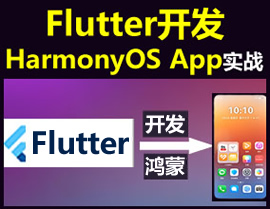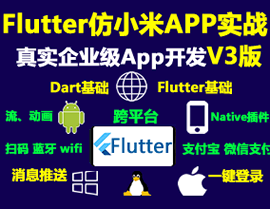Flutter深度链接管理插件flutter_deep_links的使用
Flutter深度链接管理插件flutter_deep_links的使用
介绍
flutter_deep_links 是一个用于在Flutter应用中处理深度链接的插件。通过这个插件,您可以轻松地在应用中实现深度链接的功能,包括处理从外部应用或浏览器打开应用时传递的URL。
开始使用
flutter_deep_links 插件是一个Flutter插件项目,它包含了平台特定的实现代码(如Android和iOS)。为了开始使用这个插件,您需要确保已经安装了Flutter环境,并且熟悉Flutter开发的基本概念。
添加平台支持
默认情况下,flutter_deep_links 插件项目生成时不包含任何平台支持。要添加平台支持,您可以在项目目录中运行以下命令:
flutter create -t plugin --platforms <platforms> .其中 <platforms> 可以是 android、ios、web 等。例如,如果您想同时支持Android和iOS平台,可以运行:
flutter create -t plugin --platforms android,ios .示例代码
下面是一个完整的示例代码,展示了如何在Flutter应用中使用 flutter_deep_links 插件来处理深度链接。
main.dart
import 'package:flutter/material.dart';
import 'package:flutter_deep_links/flutter_deep_links.dart';
void main() {
// 初始化FlutterDeepLinks并监听深度链接
FlutterDeepLinks.init().listen((Uri? uri) {
if (uri != null) {
print('Received deep link: $uri');
// 处理接收到的深度链接
}
});
runApp(const MyApp());
}
class MyApp extends StatefulWidget {
const MyApp({super.key});
[@override](/user/override)
State<MyApp> createState() => _MyAppState();
}
class _MyAppState extends State<MyApp> {
String _deepLink = 'No deep link received';
[@override](/user/override)
void initState() {
super.initState();
// 监听应用启动时的深度链接
FlutterDeepLinks.getInitialLink().then((Uri? uri) {
if (uri != null) {
setState(() {
_deepLink = 'Initial deep link: $uri';
});
}
});
}
[@override](/user/override)
Widget build(BuildContext context) {
return MaterialApp(
home: Scaffold(
appBar: AppBar(
title: const Text('Flutter Deep Links Example'),
),
body: Center(
child: Column(
mainAxisAlignment: MainAxisAlignment.center,
children: [
Text(_deepLink),
ElevatedButton(
onPressed: () async {
// 模拟接收一个深度链接
Uri testUri = Uri.parse('https://example.com/path?param=value');
setState(() {
_deepLink = 'Received deep link: $testUri';
});
},
child: const Text('Simulate Deep Link'),
),
],
),
),
),
);
}
}更多关于Flutter深度链接管理插件flutter_deep_links的使用的实战系列教程也可以访问 https://www.itying.com/category-92-b0.html
当然,下面是一个关于如何使用Flutter深度链接管理插件flutter_deep_links的示例代码。这个插件允许你处理应用中的深度链接(Deep Links),即用户可以通过点击一个链接直接跳转到应用内的特定页面。
首先,确保你已经在pubspec.yaml文件中添加了flutter_deep_links依赖:
dependencies:
flutter:
sdk: flutter
flutter_deep_links: ^x.y.z # 替换为最新版本号然后运行flutter pub get来安装依赖。
1. 配置AndroidManifest.xml(Android)
在Android项目中,你需要配置AndroidManifest.xml来声明你希望捕获的intent-filters。例如:
<activity
android:name=".MainActivity"
android:launchMode="singleTop"
android:theme="@style/LaunchTheme"
android:configChanges="orientation|keyboardHidden|keyboard|screenSize|smallestScreenSize|locale|layoutDirection|fontScale|screenLayout|density|uiMode"
android:hardwareAccelerated="true"
android:windowSoftInputMode="adjustResize">
<intent-filter>
<action android:name="android.intent.action.MAIN" />
<category android:name="android.intent.category.LAUNCHER" />
</intent-filter>
<intent-filter android:autoVerify="true">
<action android:name="android.intent.action.VIEW" />
<category android:name="android.intent.category.DEFAULT" />
<category android:name="android.intent.category.BROWSABLE" />
<data android:scheme="https" android:host="example.com" android:pathPrefix="/deep-link" />
</intent-filter>
</activity>2. 配置Info.plist(iOS)
在iOS项目中,你需要配置Info.plist来声明你希望捕获的URL scheme。例如:
<key>CFBundleURLTypes</key>
<array>
<dict>
<key>CFBundleTypeRole</key>
<string>Editor</string>
<key>CFBundleURLSchemes</key>
<array>
<string>yourappscheme</string>
</array>
<key>CFBundleURLName</key>
<string>com.example.yourapp</string>
</dict>
</array>3. 在Flutter代码中使用flutter_deep_links
首先,导入flutter_deep_links包:
import 'package:flutter/material.dart';
import 'package:flutter_deep_links/flutter_deep_links.dart';然后,初始化深度链接监听器,并在应用启动时检查是否有深度链接被触发:
void main() {
runApp(MyApp());
}
class MyApp extends StatelessWidget {
@override
Widget build(BuildContext context) {
return MaterialApp(
title: 'Flutter Deep Link Example',
theme: ThemeData(
primarySwatch: Colors.blue,
),
home: DeepLinkHandler(),
);
}
}
class DeepLinkHandler extends StatefulWidget {
@override
_DeepLinkHandlerState createState() => _DeepLinkHandlerState();
}
class _DeepLinkHandlerState extends State<DeepLinkHandler> {
@override
void initState() {
super.initState();
FlutterDeepLinking.initialize().then((_) {
FlutterDeepLinking.retrieveDeepLink().then((deepLink) {
if (deepLink != null) {
// 处理深度链接
print('Retrieved deep link: $deepLink');
// 根据deepLink的值导航到特定页面
// Navigator.pushNamed(context, '/someRoute', arguments: deepLink);
}
});
// 监听未来的深度链接
FlutterDeepLinking.listenDeepLink((deepLink) {
print('Received deep link: $deepLink');
// 根据deepLink的值导航到特定页面
// Navigator.pushNamed(context, '/someRoute', arguments: deepLink);
});
});
}
@override
Widget build(BuildContext context) {
return Scaffold(
appBar: AppBar(
title: Text('Flutter Deep Link Example'),
),
body: Center(
child: Text('Check console for deep links'),
),
);
}
}在这个示例中,我们首先初始化了FlutterDeepLinking,然后检索应用启动时是否有深度链接被触发。如果有,我们打印出深度链接并进行相应处理(例如,导航到特定页面)。同时,我们还设置了一个监听器来监听未来的深度链接。
请注意,这个示例代码是基于假设你已经熟悉Flutter的基本结构和导航。根据你的具体需求,你可能需要调整代码来处理不同的深度链接路径或参数。







